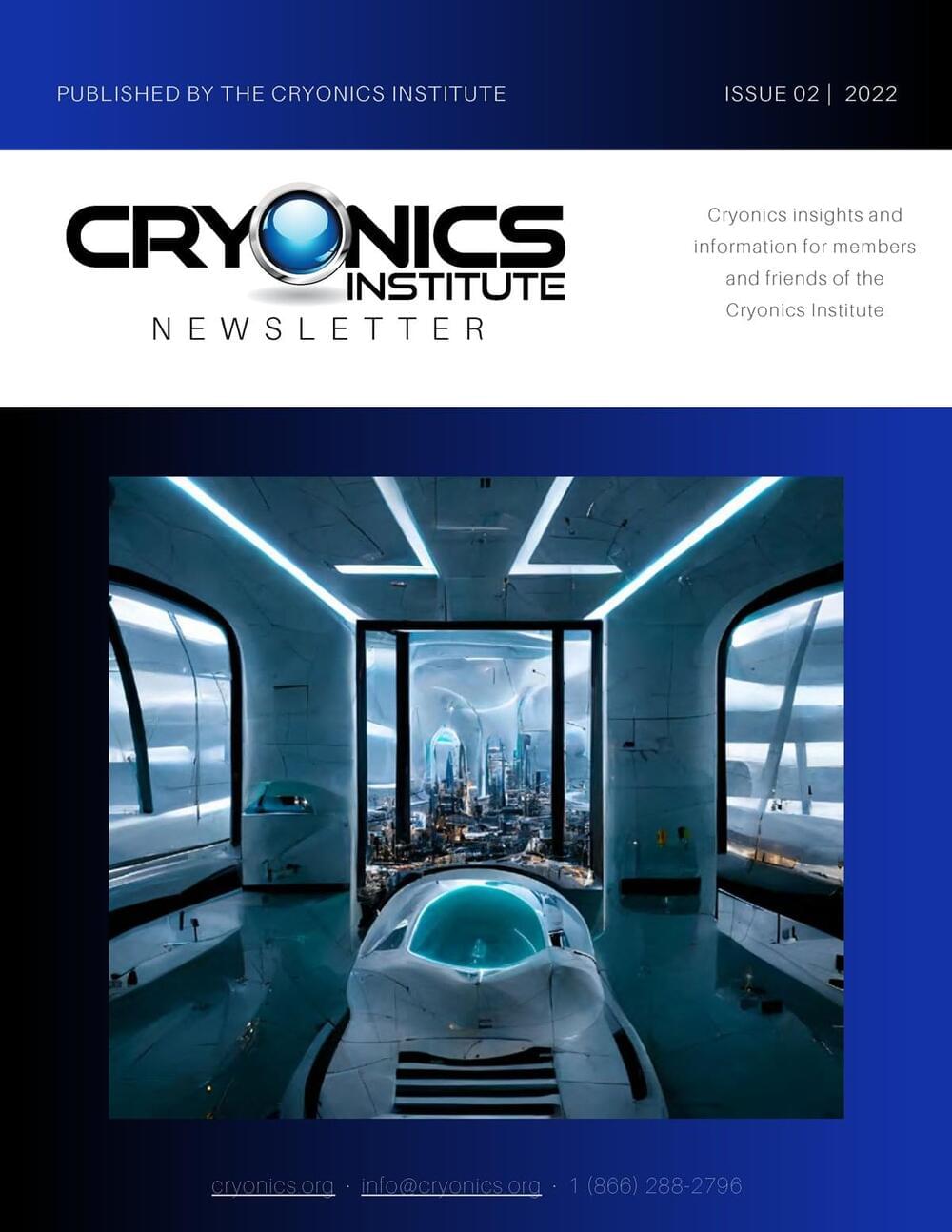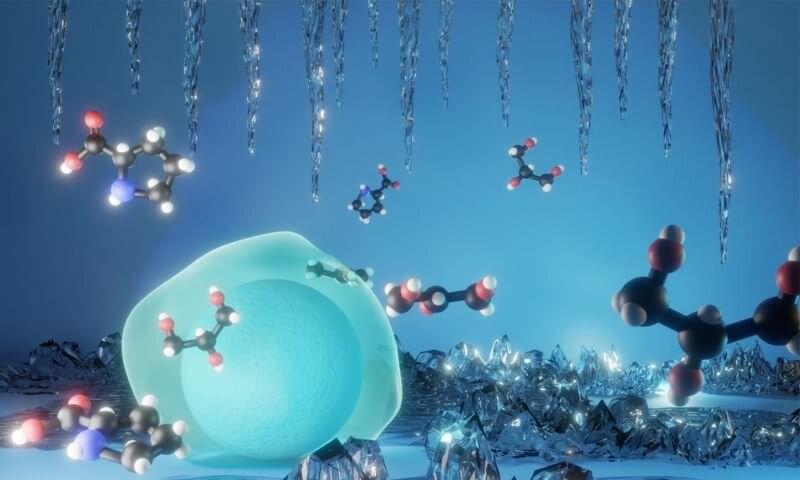Today there might not be a cure to save your life. What if the cure were available tomorrow? Biostasis (cryonics) is a possibility for keeping you around long enough for the cure.
Category: cryonics – Page 8
BI 103 Randal Koene and Ken Hayworth: The Road to Mind Uploading
Patreon support: https://www.patreon.com/braininspired.
Free Video Series: Open Questions in AI and Neuroscience:
Show notes: https://braininspired.co/podcast/103/
Randal, Ken, and I discuss a host of topics around the future goal of uploading our minds into non-brain systems, to continue our mental lives and expand our range of experiences. The basic requirement for such a subtrate-independent mind is to implement whole brain emulation. We discuss two basic approaches to whole brain emulation. The “scan and copy” approach proposes we somehow scan the entire structure of our brains (at whatever scale is necessary) and store that scan until some future date when we have figured out how to us that information to build a substrate that can house your mind. The “gradual replacement” approach proposes we slowly replace parts of the brain with functioning alternative machines, eventually replacing the entire brain with non-biological material and yet retaining a functioning mind.
Randal and Ken are neuroscientists who understand the magnitude and challenges of a massive project like mind uploading, who also understand what we can do right now, with current technology, to advance toward that lofty goal, and who are thoughtful about what steps we need to take to enable further advancements.
Timestamps.
0:00 — Intro.
6:14 — What Ken wants.
11:22 — What Randal wants.
22:29 — Brain preservation.
27:18 — Aldehyde stabilized cryopreservation.
31:51 — Scan and copy vs. gradual replacement.
38:25 — Building a roadmap.
49:45 — Limits of current experimental paradigms.
53:51 — Our evolved brains.
1:06:58 — Counterarguments.
1:10:31 — Animal models for whole brain emulation.
1:15:01 — Understanding vs. emulating brains.
1:22:37 — Current challenges.
Dr. Ralph Merkle — Nanotechnology & Cryonics — Preserving Ourselves for the Future
Ralph C. Merkle is a computer scientist. He is one of the inventors of public key cryptography, the inventor of cryptographic hashing, and more recently a researcher and speaker of cryonics.
Videos in the talk: David Eagleman https://www.youtube.com/watch?v=-5tZtYns6kE molecular nanotechnology: https://www.youtube.com/watch?v=zqyZ9bFl_qg.
Filmed 2017/04/30
Dr. Max More | This Past Weekend w/ Theo Von #404
Dr. Max More is a philosopher, writer, speaker and expert in Cryonics — the process of cryopreserving a body at the time of legal death in the hopes of reviving them in the future.
Theo talks with Dr. More about what actually happens when we die, the future of mankind, and if Theo would preserve his brain for science.
Dr. More is the Ambassador for Alcor Life Extension, a non-profit in Scottsdale, Arizona practicing cryonics. Max received a Doctorate in Philosophy in 1995 from the University of Southern California after completing a degree in Philosophy, Politics, and Economics from Oxford University.
Dr. Max More: https://www.maxmore.com/
Learn more about Alcor: https://www.alcor.org/
Tour Dates! https://theovon.com/tour.
New Merch: https://www.theovonstore.com.
Podcastville mugs and prints available now at https://theovon.pixels.com.
Support our Sponsors:

The Cryonics Institute Newsletter Issue 02
2022 https://www.cryonics.org/images/uploads/magazines/CI_NEWS-2022-02.pdfdiv.
THE CRYONICS INSTITUTE NEWSLETTER ISSUE 2, 2022 https://www.cryonics.org/images/uploads/magazines/CI_NEWS-2022-02.pdf
Natasha Vita-More — Transhumanism, Life Extension & Cryonics
Nicely done Tim!
https://www.timventura.com — Dr. Natasha Vita-More discusses transhumanism, human augmentation, life extension, and cryopreservation, and provides valuable insights into the latest medical advances empowering body augmentation & super-longevity in humans.
Our interview begins with a philosophical discussion of transhumanism, including what it is and why this emerging community is growing so rapidly — as it is driven forward by rapid advances in medical technology and an aging boomer population.
We also discuss the work of Dr. David Sinclair, Liz Parrish and Bioviva Sciences, Alcor, and a collection of notable authors, thinkers, and scientists pushing the boundaries of what it means to be human in the 21st century.
Dr. Natasha Vita-More is a pioneering leader and community organizer in transhumanism, and a proponent of human rights, morphological freedom, and ethical means for human enhancement.
“DEATH DEFANGED Cryonics, Cryothanasia and the Future of Sentience” with David Pearce
“DEATH DEFANGED Cryonics, Cryothanasia and the Future of Sentience” with David Pearce, Author, Philosopher and well-known TransHumanistThis service will be on ZOOM and YouTube Live Stream only, not in person.
Zoom at 6:00 PM Eastern Time.
Live Stream at 7:00 PM Eastern Time.
Stay after the close of the YouTube streaming for the Zoom After Party until??:00 pm. Enjoy fellowship in the extended discussions with Neal and Immortalists & Friends from Around the World, sharing bold ideas on health, longevity, and technology!(Note: Mr. Pearce was scheduled last month to give a presentation but due to circumstances beyond our control we did not have that presentation. We look forward this month to have David Pearce join us!)David Pearce is the author of 4 major works:“The Hedonistic Imperative”, “The Biointelligence Explosion: How Recursively Self-Improving Organic Robots will Modify their Own Source Code and Bootstrap Our Way to Full-Spectrum Superintelligence”, “Singularity Hypotheses: A Scientific and Philosophical Assessment”, & “Can Biotechnology Abolish Suffering?”
The Hedonistic Imperative (1995) advocates the use of biotechnology to abolish suffering throughout the living world. In 1998, he co-founded the World Transhumanist Association (H+) with Nick Bostrom. Transhumanists believe in the use of technology to overcome our biological limitations.
Currently, Pearce is a fellow of the Institute for Ethics and Emerging Technologies, and sits on the futurist advisory board of the Lifeboat Foundation. He is also the director of bioethics of Invincible Wellbeing and is on the advisory boards of the Center on Long-Term Risk, the Organization for the Prevention of Intense Suffering and since 2021 the Qualia Research Institute. Please share this event with someone that you care about. Would you like to make a Donation to Perpetual Life? Your donations help us grow & improve our services. To donate, go to our website http://Perpetual.Life and use the PayPal button at the top right of the page. Thank you for your generous donations, we appreciate it immensely!“Our task is to make nature, the blind force of nature, into an instrument of universal resuscitation and to become a union of immortal beings.“
- Nikolai F. FedorovWe hold faith in the technologies & discoveries of humanity to END AGING and Defeat involuntary Death within our lifetime. Working to Save Lives with Age Reversal Education. ========== Perpetual Life Creed ==========We believe that all of life is sacred and that we have been given this one life to make unlimited. We believe in our Creator’s divine plan for all of humanity to have infinite lifespans in perfect health and eternal joy, rendering death to be optional. By following our Gospel we achieve eternal life creating a heaven here on earth. We follow Nikolai Fyodorov, who taught that the transcendence of the creator will only be solved when humanity in our unified efforts become an instrument of universal resuscitation, when the divine word becomes our divine action. And we follow Arthur C. Clarke, who said “The only way to discover the limits of the possible is to go beyond them into the impossible.“And so, we enter each day energized in Spirit and empowered by the words of our prophets to live in joy, serving our creator and all of mankind, Forever and Ever.==========Wishing you Perfect Health and Great Longevity!Perpetual Life, a science-faith based church is open to people of all faiths & belief systems. We are non-denominational & non-judgmental and a central gathering place of Immortalists & Transhumans. What unites us is our common faith, belief and desire in Unlimited Life Spans. We are located in Pompano Beach FL at 950 South Cypress Road.
Sleeper Ships
Get Started with Squarespace today: http://squarespace.com/isaacarthur.
To journey across the stars requires voyages of centuries or more, ensuring the crew will be long dead by the time they arrive. If you want your crew available to colonize new worlds after their interstellar voyage, you either have to extend their lives, train their descendants, or freeze them till they arrive. We will examine the third option day, freezing people with cryonics, using hibernation, or suspended animation, or some other form of stasis the future might offer.
Visit our Website: http://www.isaacarthur.net.
Support us on Patreon: https://www.patreon.com/IsaacArthur.
SFIA Merchandise available: https://www.signil.com/sfia/
Social Media:
Facebook Group: https://www.facebook.com/groups/1583992725237264/
Reddit: https://www.reddit.com/r/IsaacArthur/
Twitter: https://twitter.com/Isaac_A_Arthur on Twitter and RT our future content.
SFIA Discord Server: https://discord.gg/v5UKTsz.
Listen or Download the audio of this episode from Soundcloud: Episode’s Audio-only version:
https://soundcloud.com/isaac-arthur-148927746/sleeper-ships.
Episode’s Narration-only version: https://soundcloud.com/isaac-arthur-148927746/sleeper-ships-narration-only.
Credits: Sleeper Ships.
Episode 161, Season 4 E47
Writer: Isaac Arthur.
The Goodness of the Universe — John Smart
Outer Space, Inner Space, and the Future of Networks.
Synopsis: Does the History, Dynamics, and Structure of our Universe give any evidence that it is inherently “Good”? Does it appear to be statistically protective of adapted complexity and intelligence? Which aspects of the big history of our universe appear to be random? Which are predictable? What drives universal and societal accelerating change, and why have they both been so stable? What has developed progressively in our universe, as opposed to merely evolving randomly? Will humanity’s future be to venture to the stars (outer space) or will we increasingly escape our physical universe, into physical and virtual inner space (the transcension hypothesis)? In Earth’s big history, what can we say about what has survived and improved? Do we see any progressive improvement in humanity’s thoughts or actions? When is anthropogenic risk existential or developmental (growing pains)? In either case, how can we minimize such risk? What values do well-built networks have? What can we learn about the nature of our most adaptive complex networks, to improve our personal, team, organizational, societal, global, and universal futures? I’ll touch on each of these vital questions, which I’ve been researching and writing about since 1999, and discussing with a community of scholars at Evo-Devo Universe (join us!) since 2008.
For fun background reading, see John’s Goodness of the Universe post on Centauri Dreams, and “Evolutionary Development: A Universal Perspective”, 2019.
John writes about Foresight Development (personal, team, organizational, societal, global, and universal), Accelerating Change, Evolutionary Development (Evo-Devo), Complex Adaptive Systems, Big History, Astrobiology, Outer and Inner Space, Human-Machine Merger, the Future of AI, Neuroscience, Mind Uploading, Cryonics and Brain Preservation, Postbiological Life, and the Values of Well-Built Networks.
He is CEO of Foresight University, founder of the Acceleration Studies Foundation, and co-founder of the Evo-Devo Universe research community, and the Brain Preservation Foundation. He is editor of Evolution, Development, and Complexity (Springer 2019), and Introduction to Foresight: Personal, Team, and Organizational Adaptiveness (Foresight U Press 2022). He is also author of The Transcension Hypothesis (2011), the proposal that universal development guides leading adaptive networks increasingly into physical and virtual inner space.
A talk for the ‘Stepping into the Future‘conference (April 2022).
The Goodness of the Universe: Outer Space, Inner Space, and the Future of Networks /w John Smart
Many thanks for tuning in!
Have any ideas about people to interview? Want to be notified about future events? Any comments about the STF series?

Organ storage a step closer with cryopreservation discovery
Australian scientists have taken the first step towards improved storage of human cells, which may lead to the safe storage of organs such as hearts and lungs.
The team’s discovery of new cryoprotective agents opens the door to many more being developed that could one day help to eliminate the need for organ transplant waiting lists. Their results are published in the Journal of Materials Chemistry B.
Cryopreservation is a process of cooling biological specimens down to very low temperatures so they can be stored for a long time. Storing cells through cryopreservation has had big benefits for the world—including boosting supplies at blood banks and assisting reproduction—but it is currently impossible to store organs and simple tissues.